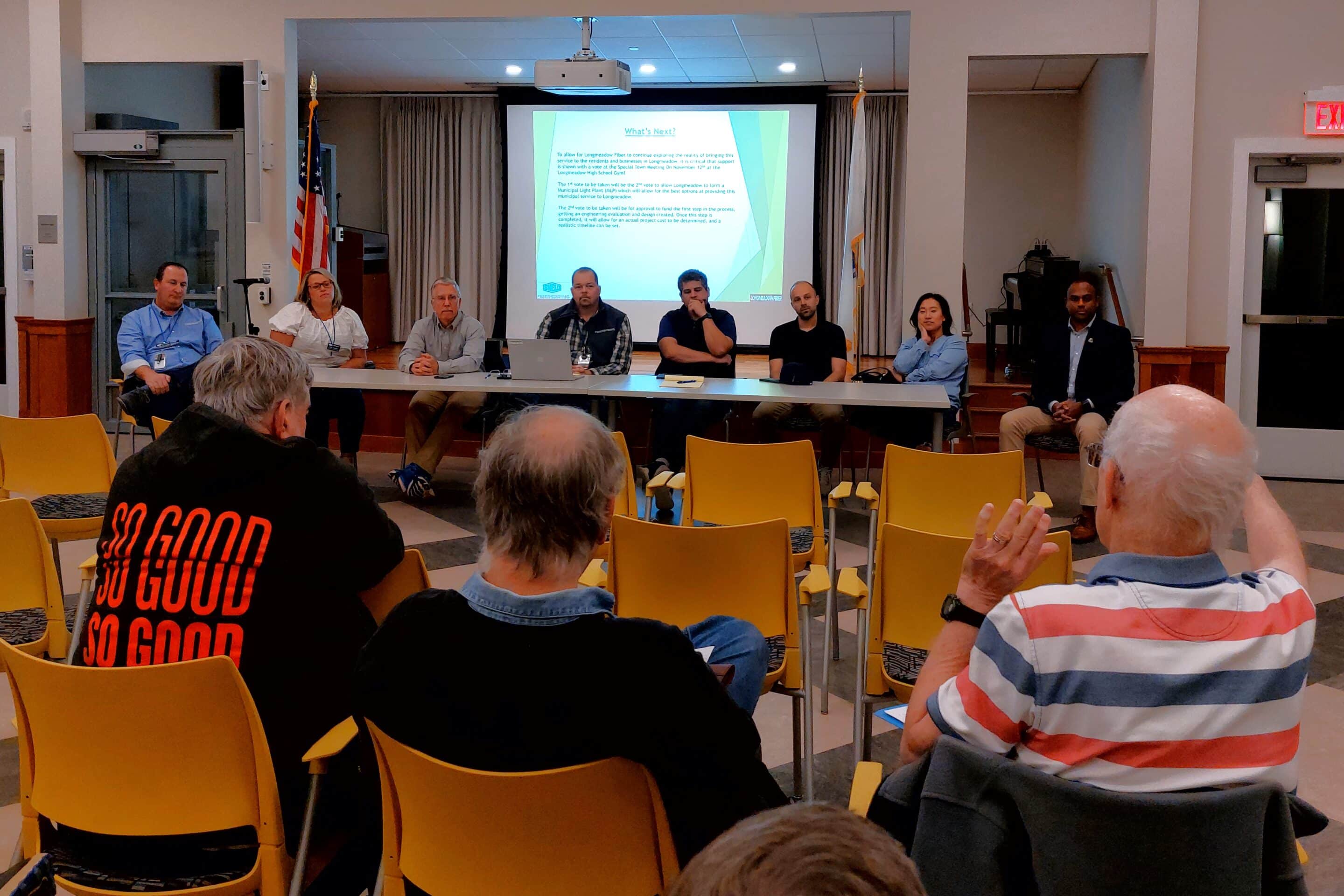Residents ask questions for the Municipal Fiber Task Force and Fiberspring representatives Adam St. Martin, Kelly Frazier and Bobby Liswell.
Reminder Publishing photo by Sarah Heinonen
LONGMEADOW — Cities and towns across Western Massachusetts are exploring municipally owned internet networks. Chicopee, Westfield and South Hadley operate networks, while Hampden, East Longmeadow, West Springfield, Wilbraham and Southwick are at various stages of municipal fiber projects with different internet service providers.
Longmeadow is also on the list, pursuing a town-owned network through a partnership with South Hadley’s service, Fiberspring.
South Hadley has long had a municipal light plant, something required by state law for cities and towns to operate a utility. South Hadley has operated an electricity utility, South Hadley Electric Light Department, for more than 100 years and a fiber optic broadband and phone service since 2018. The town recently finished the buildout of its townwide fiber optic network, six months ahead of schedule and under budget, said Kelly Frazier of SHELD. In the meantime, it also began expanding its footprint, establishing networks in partnership with Shutesbury and Leverett.
Longmeadow’s first Town Meeting vote to establish a municipal light plant took place in May. The legally required second vote will be taken at the Nov. 12 Town Meeting. The town’s Municipal Fiber Task Force hosted a public forum with representatives from South Hadley Electric Light Department, which operates Fiberspring, on Oct. 9.
The town is pursuing a local fiber network for a few reasons. The first is competition. Frazier said Fiberspring’s fiber optic internet service is $70 per month. This incentivizes companies, such as Xfinity and Verizon, to reduce their prices in the market, she said.
With local ownership of the infrastructure, the town receives revenue from customers, which can be reinvested into the municipal light plant. Municipal Fiber Task Force Chair Vineeth Hemavathi said that $30 of each customer’s monthly bill will go to Fiberspring as the internet service provider. The remainder will go to the town’s municipal light plant board.
“We’re not in it for a large profit share,” said SHELD Telecommunications and AMI Meter Manager Bobby Liswell.
Fiber typically provides faster upload and download internet speeds with less lag than cable broadband. And there is a greater capacity to accommodate more internet-connected devices, including “smart” appliances. Liswell said fiber connections are not affected by power surges. John Hine, a member of the South Hadley Municipal Light Plant Board said it also adds value to a home when selling.
“The benefits are pretty endless,” Frazier said.
Installation of a fiber connection would be completely voluntary, and the network could be rolled out in sections, or “fiberhoods,” based on where the most interest lies.
While the establishment of a municipal light plant requires no funding, a second article on the Nov. 12 warrant will seek $490,000 from free cash for preliminary network design work and applications for pole permits. The permits are required because the fiber lines would run along existing utility poles, owned by Eversource and Verizon.
The network buildout is expected to take up to five years and to cost $25 million. Municipal Fiber Task Force member Ben Brown said that rather than bonding for the entire project, bonds can be taken out to cover one fiberhood at a time. Hemavathi noted that West Springfield is funding its network that way. He later added that the revenue from each fiberhood can then be used to pay off some of the debt or to fund the next section of the buildout. Hine said that South Hadley was receiving revenue that covered its expenses within three and a half years. Within five years, the debt service was covered.
While the forum had few residents in attendance, the ones who came had plenty of questions. Tom Shea asked about the timeline for the project. Hemavathi explained that the pole applications take about two years for approval in Massachusetts. The design work would be completed at the same time, with the goal of being ready for installation as soon as the permits are approved.
Select Board member Mark Gold asked if pull permits need to be sought throughout the town, whether or not they are in a fiberhood with active installation. Brown said that an application for every poll in town will be sought at the same time. Even if the installation is rolled out one fiberhood at a time, returning more than once to seek permission from power companies would extend the process.
“We want to make the best use of that time,” said Liswell. Design work would begin in November, as soon as the funding is approved.
Resident Larry Star was neither for nor against the project. He said he already receives nearly 1 gigabit speed upstream and downstream from his Xfinity cable internet connection and was skeptical that 2GB would be needed by 2030, as Fiberspring stated. “What are we fixing?” he asked.
Municipal Fiber Task Force member Mike McLane said, “The technology we’re relying on has limitations.” Hemavathi added, “We’re asking the town to think ahead and way into the future. Comcast will never make the investment in fiber to the home.”
As evidence of this, Brown said that the task force had consulted a private internet service provider and they were told, “The [return on investment] is not in Longmeadow.”
Starr reiterated that his needs were satisfied with his current connection. Hemavathi pointed out that not everyone had the same situation. “You’re talking about families with kids,” he said.
Frazier said people are often concerned with the customer service they receive from their internet companies. For SHELD, she said, customer service is where it excels. With its headquarters in South Hadley, SHELD can provide service to western Massachusetts customers in a matter of hours rather than scheduling a four-hour window on a future day for a technician to arrive, she said.
A resident said that he already “cut the cord,” eliminating cable TV programing and choosing to stream content, instead. He asked, “What can you offer me that I can’t already do?”
McLane said, “Right now, I pay over $100 a month. I haven’t had cable for years.” With Fiberspring, he said, “I’ll be paying less for higher speeds. Hine told the resident people do not have to go all in with either Fiberspring or Xfinity. He explained that he had Fiberspring internet and streamed Xfinity’s cable television content.
Once approved in November, people will be able to signal their interest at fiberspring.com, where a Longmeadow tab will be available. There, people can also learn about the network and how it will work. People who express interest will be notified when they are able to connect to the network. Frazier said each connection is blocked off for a four-hour period so the technician can take as much time as needed to answer questions and even hookup devices.
Because SHELD is owned by South Hadley, the design and engineering plans will be covered under an intergovernmental agreement between it and Longmeadow, Brown said. A second intergovernmental agreement would be negotiated to cover construction of the network. SHELD partners with Holyoke Gas & Electric to install the “middle mile,” bringing the fiber into town. SHELD would oversee the “final mile” installation, as the project manager.
In areas where utility lines run underground, Liswell said the town would run its own conduit down the street.
One person said, “This is not like water and sewer. You can call it a utility, but it’s an optional one.”
McLane contended that the internet is a necessity. He said both he and his children have used remote schooling options, and he works remotely at times.
Gold called it a “generational issue.” He said Longmeadow has a high percentage of older residents who may not see the value of a fiber network and said he was concerned that the expected take rate was based on a younger population. When the Select Board met with representatives from Fiberspring in September, it was estimated that a take rate of higher than 40% would be needed to break even and closer to 50% would be required to turn a profit for the town.
“Take a look at the demographics of South Hadley,” said Hine. There, he said, there was a nearly 50% take rate. It other words, half of all internet customers in town had signed on. “It doesn’t matter if you’re 7 or 70, the internet is part of our life.”
Hemavathi added, “In the research [the task force] did, we did not find any community that has not met the take rate.” He later said that once customers begin being connected, interest in the network catches on and “you can’t build fast enough.”



